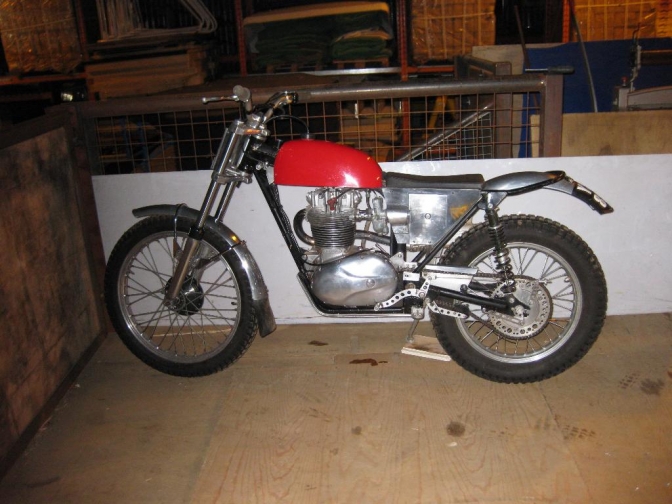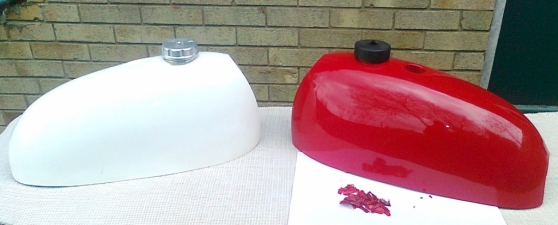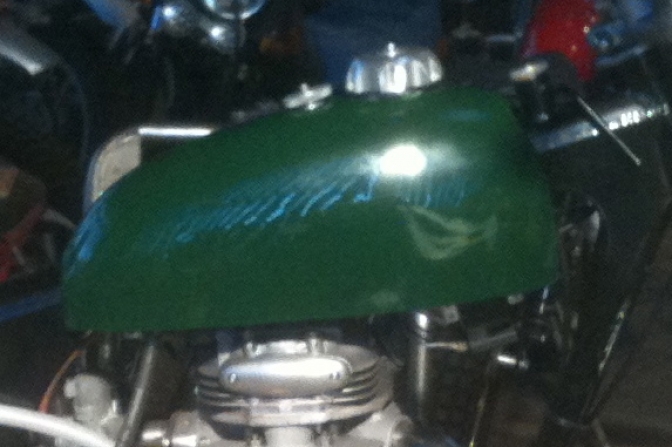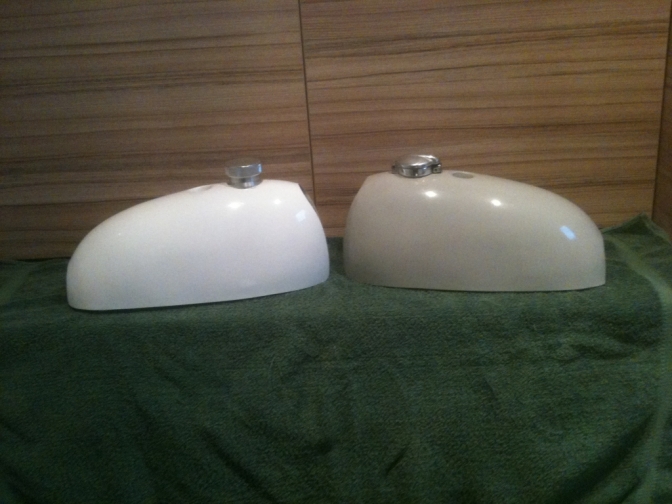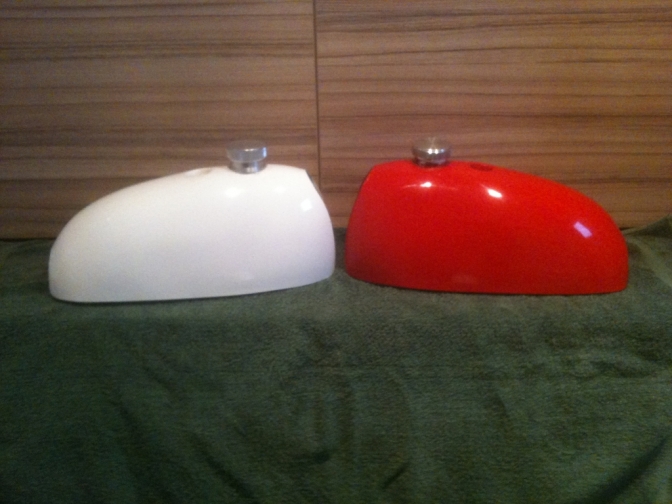Glass Reinforced Plastic fuel tanks, for your BSA and Triumph “Otter”.
"Bessie"BSA Otter built by Paul Beswick...
31/3/2012.
OK... I have done a bit of a study on these tanks, has I feel they are just has reliable, as an alloy tank of twice the price.
With the new 15% ethanol added to petrol/gas. There is a problem? Ethanol eats away at normal polyester based resins; often softening the entire tank and making it like jelly. Usually though it will find the weakest point in the layup of the tank, and form a big blister that eventually bursts, and renders the tank unusable, and scrap. So is there a short cut to make a polyester tank usable with fuels of today? The answer is NO, not really...
If you have had today’s fuel in your Glass Fibre tank, it has already been attacked with the ethanol. You could try to rectify the situation by thoroughly cleaning out the tank, and leaving it ventilated for at least 10 days with the cap and tap removed. But there is no guarantee that you have got rid of all traces of “E” then. What you now could do is to buy an amount of vinylester based resin and slosh coat the inside of the tank, leaving it at least another 10 days when dry, to cure slowly in a well heated environment. It has been advised that you could also use the polyester based resin Crystic 199, from Scott-Barder to slush coat your tank, although on paper this seems OK... it is still along with the Vinylester resins readily available in small quantities, that are bis-phenol “A” based it is still going to fail in the long term... Other coating’s are available that are said to be today’s fuel proof, that you could slosh coat the inside of your tank with, but they are also very messy and never seem to set, colouring the fuel that you put in, and I can’t see doing the inside of your engine a lot of good.
OK... Most reputable suppliers of New GRP trials tanks, are now using Vinylester resin in there construction, but has I have said above whether this resin is bisphenol “A” based, one would not know. And if they are constructed by a cottage industry, whether they are manufactured with the right degree of skill, and in the right environment to achieve a recognised standard, which is now a must in the industry. Tanks could be constructed using the correct resin, which is a Novalac bisphenol”F” based vinyl ester resin, such has Derakane 470? But this resin is only available in 205 kg kegs, that manufacturers won’t split into small quantities, because the resin only has a shelf life, at the max five months. And trials tank makers are not going to shell out over £1000, for a keg of this resin to throw most of it away after five months. So unless trials tanks are being made by a large concern that uses this resin readily over this period of time, the bets are it is not being used? I know of one twin shock trials based company, that have their tanks made with this resin by a large concern, with years of commercial GRP manufacture. But unless other trials tank suppliers are also using large companies to produce their tanks I don’t know!
The tanks above are a good example. They both came from a Ray Small tank mould. The red tank is five years old, ("Bessie's" tank) and had been slosh coated with an unidentified resin, and has you can see, some flaking has already occurred. The white tank is new, this week, (2015) from Sammy Miller Products, and is made using, I quote, “Vinyl-ester resin and an improved bonding paste”. I hope the tank does as it says on the tin, so to speak. We shall see.
So there you are, you pays your money, and takes your choice...
One tip is, to not to leave fuel in the tank when you are not using the bike, and leave the cap off to get rid of the fumes.
It is also a good idea to drain the carburettor from fuel if you are not using the bike for a while, because ethanol, also tries to eat away at zinc based products too.
21/10/2012.
This is an update to the GRP tank problems with the now common ethanol based fuels. Over the past month I have made a couple of new tanks, in my Ray Small copy mould, (I love the shape of this tank). The first one I made using the only vinyl ester resin that is commonly available which is purported to be ethanol resistant but is not guaranteed. I got this from East coast glass-fibre supplies. The resin is a bit more difficult to work with than normal polyester that is used in most GRP lay up, but the tank has turned out fine. This is the racing green tank. The other tank the white one, below, is made using normal polyester resin, this I am then going to slush coat with Caswells GTS 1750 Novalac tank sealing resin, which is the right formulation epoxy resin to be ethanol proof. This is probably the only way that you can get your hands on small amounts of this resin. (read the earlier story), although it is expensive, I reckon I will have enough from one batch, that I am buying from agents Hitchcock’s Motorcycles from Solihull, to coat three of the Ray Small tanks. So £ 45 does not seem that bad then. We will then trial the tanks in more ways than one, and see what happens? I have made a tank from just polyester resin (the Grey one) and we will see how long this lasts before deterioration.
I have deliberately made the grey tank thicker than normal making it slightly heavier but this should hopefully last longer? The red tank below is thin? This tank is to be used with the Shell, and Esso, fuel, that is said to contain very little ethanol, if any? We will see.
|
Update October 2015.
There is now a better alternative than struggling to find the right mix of resin, or a tank that is said to be made of the right stuff, and turns out to not last very long.
The alternative, well?
Aspen ethanol free fuel.
Check on the Aspen page for information.
I must say the tests I have done do seem to be conclusive in what is said about the fuel.
With no reaction, even with a "green" freshly laid up polyester tank, with only a couple of weeks curing time.
I will continue to monitor the situation, and let you know the results.

Photo Credit ... Chris Smith.
More Later when we do some basic tests.
Check out the Aspen site yourself. and see what you think. http://www.aspenfuel.co.uk
~~~~~~~
11/08/2019...
Now I am using the Aspen fuel in all of my tanks, and even found a petroleum fuel from Esso without the dreaded ethanol, I am quite content to continue to fabricate my glass fibre tanks with just polyester resin...
But I have recently found a new epoxy resin that has all the qualities to use for hand lay up, and is said to be ethanol and other chemicals resistant..
The problem is, it is expensive compared with the polyester resin.
So whether it warrants the use of it is still a decision to make.
I will try and get a sample batch to try and make one tank to see how it turns out...
The company that makes the resin is not far from me, so that is a bonus. And I have spoken to them before, and bought materials from them.
SO watch this space, and we will see what happens...

This SMP tank is claimed to be ethanol resistant?
We still have to prove that...
More Later.
Updat2023...05...


